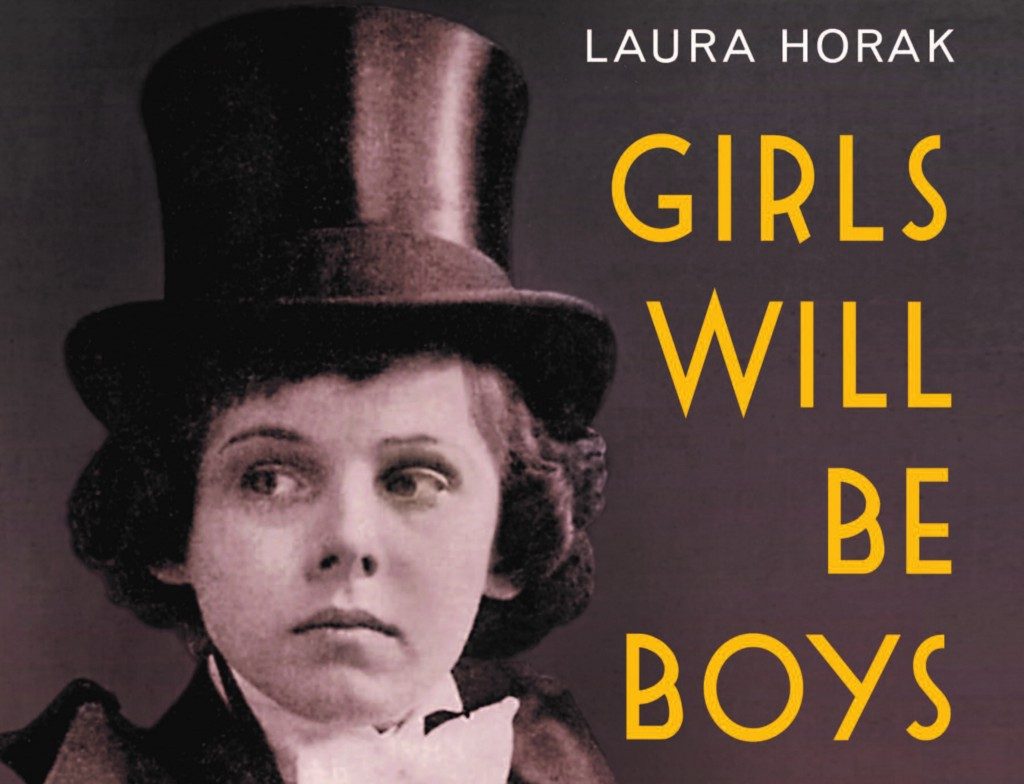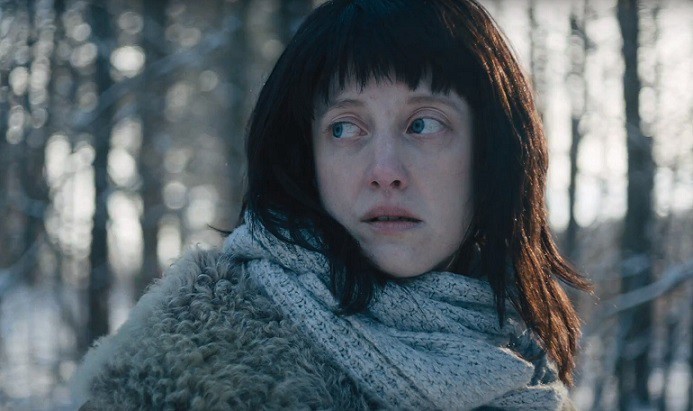Laura Horak tells of a time when cross-dressed women and lesbians roamed the screen in “Girls Will Be Boys: Cross-Dressed Women, Lesbians, and American Cinema, 1908–1934.” Here, Horak introduces a condensed excerpt of the book for Women and Hollywood readers.
My students are generally of the opinion that the present time offers women the most opportunities in the movies, in terms of the variety of roles they can play in front of the camera and behind it. Even though we are far from parity, things are getting better, right?
They are shocked when I tell them that women have fewer opportunities in film today than when the medium first started. During the silent era, and particularly the period from around 1908 to the mid-1920s, hundreds of women worked as directors, producers, screenwriters, and headed production companies, as described by the ever-expanding Women Film Pioneers Project. What’s more, the types of roles available on screen were remarkably varied. Female action heroes like Pearl White helmed popular film serials, and women regularly played inventors, journalists, scientists, mothers, daughters — and also sons.
Women played boy roles (“straight,” so to speak) in more than 100 American films during the silent era. Women also played cross-dressing soldiers, spies, cowboys, prospectors, and thieves. After more than ten years scouring archives across the US and Europe, I discovered almost 500 American silent films featuring cross-dressed women. I found that lesbians and “sexual inverts” had already begun to grace American screens in the 1920s — first in brief cameos in films like the Academy Award-winning “Four Horsemen of the Apocalypse” (1921) and eventually as protagonists in sound films like “Queen Christina” (1933/34). Sometimes the films used men’s clothing to communicate women’s sexual identity, but sometimes they didn’t, and ordinary women began to adopt men’s formal wear in order to look as modern as Dietrich and Garbo. The films I found were not only popular with audiences — they helped change norms of gender and sexuality and make cinema the dominant American entertainment. My new book, “Girls Will Be Boys: Cross-Dressed Women, Lesbians, and American Cinema, 1908–1934” (Rutgers University Press, 2016), describes these discoveries.
Below is an excerpt from the introduction:
Girls will be boys in the movies, as well as anywhere else.
— “They Love Acting in Boys’ Clothing,” Manitowoc Daily Herald (August 24, 1917)
Marlene Dietrich lights a cigarette, straightens her bow-tie, and adjusts her top hat. Clad in a black tailcoat, she strides onto a modest stage. She is met with jeers. While she waits for quiet, the camera lingers on her sculptural face, sharply drawn eyebrows, and ironic smile. She saunters over to the audience, leans on a railing, and begins to sing. After the song, she accepts champagne from a male admirer, then spies the man’s date. She looks the woman up and down; the woman titters nervously. Dietrich plucks a flower out of the woman’s hair, lifts it to her face and smells it, then leans down suddenly, takes the woman’s chin in her hand and kisses her firmly on the mouth. The audience laughs and applauds, the woman hides her face in pleased embarrassment, and Dietrich smiles, sniffs the flower, and flicks the brim of her hat. Dietrich turns toward the audience and raises her hat, accepting the applause.
This scene from “Morocco” (Paramount, 1930) is one of the most famous cross-dressing scenes in cinema history. Queer viewers have embraced it as an isolated and cherished expression of lesbian desire and sensual androgyny.1 Alongside Greta Garbo’s cross-dressed monarch in “Queen Christina” (MGM, 1933/34) and Katharine Hepburn’s cross-dressed con woman in “Sylvia Scarlett” (RKO, 1935/36), Dietrich’s Amy Jolly is often characterized as one of the lone early representations of women cross-dressing and expressing desire for other women in American cinema.
Furthermore, the meaning of women dressing like men in these movies seems obvious. They are transgressive. They challenge patriarchy and the gender binary. Their clothing probably also signifies lesbianism, at least to those “in the know.” Many viewers assume that the only way movies could represent lesbianism back then was through masculine clothing. They also assume that neither cross-dressed women nor lesbians showed up much in American films.
As it turns out, none of these assumptions is true. Where previous accounts have identified only 37 silent American films featuring cross-dressed women, I have discovered more than 400.2 Far from being inherently transgressive, cross-dressed women in early twentieth-century America were associated with wholesome entertainment.
In the first part of this book I will show that the American moving picture industry used cross-dressed women in the 1910s to help the medium become respectable and appeal to audiences of all classes. Cross-dressed actresses embodied turn-of-the-century American ideals of both boyhood and girlhood. The second part of the book traces the emergence of lesbian representability in American popular culture between the 1890s and 1930s. Only in the late 1920s, in the wake of the multi-year censorship battles over the play The Captive, did codes for recognizing lesbians begin to circulate among the general public — codes that included, but were not limited to, male clothing. This development tarnished cross-dressed women’s wholesomeness and inspired the first efforts to regulate cinema’s cross-dressed women. It also established the transgressive meanings with which we are familiar today. This book ends where other accounts of cross-dressed women and lesbians in American cinema begin — with Dietrich, Garbo, and Hepburn.
Previous scholars have read representations of cross-dressed women as mirrors of their own concerns and identities. That is, feminist scholars have read cross-dressed women as feminists;3 lesbian scholars have read them as lesbians;4 and queer and postmodern scholars have read them as queer and postmodern.5 Transgender scholars have considered cross-dressed individuals as examples of historical gender variance, though they usually stop short of claiming them as trans.6 Indeed, the open meanings of cross-dressed women are a key part of their appeal. But scholars’ interpretive zeal has obscured the ways that representations of cross-dressed women were understood at the time they were made and circulated.
Reading cross-dressed women as embodiments of contemporary concerns flattens and sometimes misrepresents the cultural work that they were doing in their own times. While my interest in historical representations of cross-dressed women is inspired by my present-day experiences of gender and sexuality, in this project I have tried to stay open to what they meant in their own contexts. One of the surprising things I discovered was that cross-dressed women were not inherently subversive and were sometimes mobilized in support of nationalist, white supremacist ideologies. Rather than making abstract identitarian claims for these figures, this book explores the multiple, contradictory meanings attached to them, how these interpretations developed, and why they changed. Following the lead of transgender studies scholars, I attend to the diversity and specificity of historical gender expressions rather than thinking of them as mere prototypes for later identity categories. As I will show, cross-dressing has never meant any one thing, and it is impossible to describe its meanings without examining specific cases and contexts.
Because we cannot assume, a priori, that cross-dressing was viewed as a sign of lesbianism or sexual inversion, I instead looked for instances in which cross-dressing aligned with other narrative, formal, and intertextual signs of lesbianism or inversion. I also searched for instances in which critics and censors named characters as lesbian or inverted, either directly or by using established codes. This approach allows us to trace when and where lesbianism achieved mass legibility (and, conversely, when and where it was obscured). While I recognize that individuals’ ability to “read” lesbianism depended on many idiosyncratic factors, I use national, local, and community newspapers to gauge when journalists imagined that their readers could catch these references. This approach admittedly prioritizes the understandings of the general public over those of lesbians and inverts themselves. However, when mass legibility emerged, it must have profoundly affected the lives of lesbian and inverted individuals; they found themselves under new surveillance, but also with new capacities to recognize each other and build far-flung communities.
To read more, buy the book from Rutgers University Press.
Footnotes
1. For example: Edith Becker et al., “Lesbians and Film,” Jump Cut 24–25 (March 1981): 17–21; Judith Mayne, “Directed by Dorothy Arzner” (Bloomington: Indiana University Press, 1994), 103.
2. Homer Dickens, “What a Drag: Men as Women and Women as Men in the Movies” (New York: Quill, 1984). Rebecca Bell-Metereau lists only seven silent films featuring cross-dressed women in her “Hollywood Androgyny,” 2nd ed. (New York: Columbia University Press, 1993).
3. Dianne Dugaw, “Warrior Women and Popular Balladry, 1650–1850” (Cambridge and New York: Cambridge University Press, 1989); Julie Wheelwright, “Amazons and Military Maids: Women Who Dressed as Men in the Pursuit of Life, Liberty and Happiness” (London: Pandora, 1989); Susan Gubar, “Blessings in Disguise: Cross-Dressing as Re-Dressing for Female Modernists,” Massachusetts Review 22, no. 3 (1981): 477–508.
4. San Francisco Lesbian and Gay History Project, “‘She Even Chewed Tobacco’: A Pictorial Narrative of Passing Women in America,” in “Hidden from History,” ed. Martin Duberman, Martha Vicinus, and George Chauncey (New York: Meridian Books, 1990), 183–94; Esther Newton, “The Mythic Mannish Lesbian: Radclyffe Hall and the New Woman,” Signs 9, no. 4 (1984): 557–75; Lisa Duggan, “Sapphic Slashers: Sex, Violence, and American Modernity” (Durham, NC: Duke University Press, 2000).
5. Susan M. Gilbert, “Costumes of the Mind: Transvestism as Metaphor in Modern Literature,” Critical Inquiry 7, no. 2 (1980): 391–417; Marjorie Garber, “Vested Interests: Cross-Dressing and Cultural Anxiety” (New York: Routledge, 1992).
6. Louis Sullivan, “From Female to Male: The Life of Jack Bee Garland” (Boston: Alyson Publications, 1990); Judith Halberstam, “Female Masculinity” (Durham, NC: Duke University Press, 1998); Nan Alamilla Boyd, “The Materiality of Gender: Looking for Lesbian Bodies in Transgender History,” Journal of Lesbian Studies 3 (1999): 73–82; Clare Sears, “All That Glitters: Trans-ing California’s Gold Rush Migrations,” GLQ: A Journal of Lesbian and Gay Studies 14, nos. 2–3 (2008): 383; Peter Boag, “Re-Dressing America’s Frontier Past” (Berkeley: University of California Press, 2011).
(Adapted from “Girls Will Be Boys: Cross-Dressed Women, Lesbians, and American Cinema 1908–1934.” New Brunswick: Rutgers University Press, 2016. Copyright © 2016 by Laura Horak. Reprinted by permission of Rutgers University Press.)
Laura Horak (@thelorak) is an assistant professor of Film Studies at Carleton University. She is currently writing a book about Swedish cinema’s role in forging new approaches to sexuality in the 1920s. She is also researching the history of transgender and gender variant moviemakers. She is co-editor of the award-winning “Silent Cinema and the Politics of Space.”







